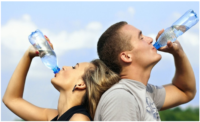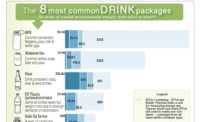Bottled water is officially America’s favorite packaged beverage

Americans are drinking more bottled water than any other packaged beverage – outselling carbonated soft drinks, by volume, for the first time in history, the International Bottled Water Association (IBWA) and the Beverage Marketing Corporation (BMC) announce.
Healthy, convenient, and safe, bottled water is America’s favorite packaged drink, according to the latest data from BMC. Bottled water sales increased by 10% in 2016, and now total $16 billion (wholesale). In 2016, total U.S. bottled water consumption grew by 8.6% to 12.8 billion gallons, up from 11.8 billion gallons in 2015. In addition, per-capita consumption is up 7.7% in 2016, with every person in America drinking an average of 39.3 gallons of bottled water last year, while average intake of carbonated soft drinks slipped to about 38.5 gallons, BMC statistics show.
Bottled water has become consumers’ No. 1 drink for many reasons, says Joe Doss, IBWA president and CEO. “Research and polling indicate people are continuing to make the switch from other packaged drinks to bottled water. Some of these reasons include:
- Bottled water is a healthy packaged drink choice.
- Bottled water tastes great and is refreshing.
- Bottled water is convenient for on-the-go lifestyles.
- Bottled water has trusted safety and quality and is comprehensively regulated by the U.S. Food and Drug Administration (FDA).
- Bottled water packaging has a proven record of safety.
- Bottled water is sold in containers that are 100-percent recyclable.
- Bottled water has the lowest water and energy use ratio of all packaged beverages.
- Bottled water has a tiny water-use footprint. The entire industry uses less than 0.011 percent of all water used in the United States each year.
- Bottled water containers use much less PET plastic than soft drinks containers (9.89 grams vs. 23.9 grams, on average for 16.9-ounce containers). Soda needs a thicker plastic container due to its carbonation.
BMC data from the past two decades shows that a large part of the sales growth for bottled water is the result of a “consumer shift” from sugar-sweetened beverages to bottled water, says Doss.
“Bottled water effectively reshaped the beverage marketplace,” says Michael C. Bellas, chairman and CEO, Beverage Marketing Corporation. “When Perrier first entered the country in the 1970s, few would have predicted the heights to which bottled water would eventually climb. Where once it would have been unimaginable to see Americans walking down the street carrying plastic bottles of water, or driving around with them in their cars’ cup holders, now that’s the norm.”
“With the exception of two relatively small declines in 2008 and 2009 – when most beverage categories contracted – bottled water volume grew every year from 1977 to 2016. This period included 17 double-digit annual volume growth spurts. Since resuming growth in 2010, bottled water volume has consistently enlarged at solid single-digit percentage rates,” says Bellas.
A Harris Poll conducted for IBWA found 86% of people polled purchase bottled water.
Reflecting a clear trend of consumers increasingly choosing safe, healthy, convenient, zero-calorie bottled water, BMC reported that in 2016, bottled water had achieved a new volume record – 4 billion gallons higher than it had been in 2007. Soft drinks, on the other hand, underwent their eleventh consecutive year of volume reductions in 2016.
“Bottled water’s versatility makes it suitable for consumption at any time of day and in just about any setting or situation. It doesn’t need to be kept cold (like soft drinks or juice) or warm (like conventional coffee or tea). And various packaging types, ranging from 3- and 5-gallon bottles used in homes and offices to single-serve containers sold at retail locations, facilitate a variety of uses,” says Doss.
“Amid worries about obesity, diabetes, heart disease, and other health matters, bottled water’s lack of calories and artificial ingredients, convenience, and refreshing taste attracts health-conscious consumers.
“And as some consumers are becoming wary of artificial sweeteners, they are abandoning diet as well as regular soda and instead are switching to bottled water.
"The bottled water industry is utilizing a variety of measures to continue reducing its environmental impact. Many bottled water companies are already using recycled plastic in their bottles. Some are already producing 100-percent recycled PET plastic bottled water containers," he adds. “Bottled water’s environmental footprint is the lowest of any packaged beverage, according to a life cycle assessment conducted by Quantis,"
“When it comes to overall water use, the bottled water industry is actually a small and efficient water user. Bottled water uses only 0.011 percent of all water used in the United States.”
The results of a benchmarking study show that the amount of water and energy used to produce bottled water products in North America is less than all other types of packaged beverages. On average, only 1.32 liters of water (including the liter of water consumed) and 0.24 mega joules of energy are used to produce 1 liter of finished bottled water.
Doss says the bottled water industry works hard on a number of fronts with recycling advocates, communities, and beverage and food partners to increase recycling rates. At 35.4%, the recycling rate for single-serve PET plastic bottled water containers has more than doubled in the past 10 years, and PET plastic bottled water containers are the most frequently recycled PET beverage container in curbside recycling programs. PET plastic bottled water containers, measured in tons of landfill space, make up just 3.3% of all beverage containers that end up in landfills. Waste percentage numbers are much higher for the glass (66.7%), aluminum (7.9 %), and plastic soda bottles (13.3%) that end up in landfills. In addition, between 2000 and 2014, the average weight of a 16.9-ounce (half-liter) PET plastic bottle has declined 51%. This has resulted in a savings of 6.2 billion pounds of PET resin since 2000.
Bottled water is comprehensively regulated as a food product by FDA, and FDA regulations governing the safety and quality of bottled water must, by law, be as stringent as the Environmental Protection Agency (EPA) standards for tap water. And, in some very important cases, such as lead, bottled water regulations are substantially more stringent.
Looking for a reprint of this article?
From high-res PDFs to custom plaques, order your copy today!






